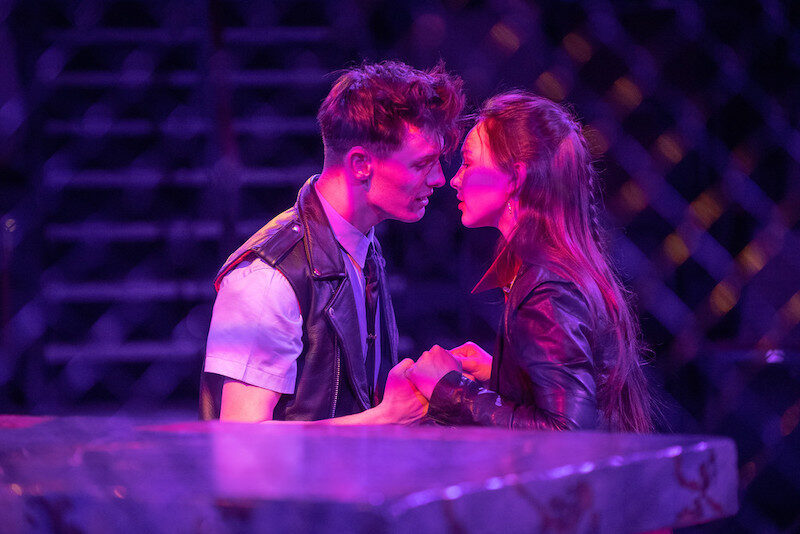ACT’s Romeo + Juliet: Beautiful but Problematic
Review of Romeo + Juliet at ACT Theatre.
Written by Faith Elder during TeenTix’s Theater & Dance Press Corps Intensive.

Police sirens wail as officers dressed in riot gear rush in, followed by parents who cry for their children. To an unknowing spectator, this could be the beginning of a crime thriller. But this is no murder mystery, it is a four hundred year-old tragedy.
ACT Theater’s Romeo + Juliet, directed by John Langs, brings a Shakespearean classic into the modern world to address the violence and anger that today’s youth face. The production, part of the season’s goal of bringing new life to older works, also added a new dimension to the story with the casting of Deaf actors in the roles of Romeo and Friar Lawrence. But while this production incorporates stunning performances by both Deaf and hearing performers, the romance becomes questionable when brought into today’s societal norms.
The classic tale of Romeo + Juliet tells the story of a pair of lovers whose families are enemies, forcing them to keep their love a secret. But after their secret wedding, a clash between the Capulet and Montague families separates the lovers. Desperate to escape another marriage, Juliet (Gabriella O’Fallon) and Friar Laurence (Howie Seago) devise a plan to return her to Romeo. Unfortunately, miscommunication results in tragedy.
To bring this story into the present, the Allen Theater at ACT is transformed into a dark, grungy space, similar to a junkyard or an inner-city alley. Walls are covered with trash bags and chain link fences, the stage is set with a rolling table and three walls made of chain link. Though a simple design, both the table and the walls can be moved by performers, becoming versatile and imitating a variety of set pieces. Costumes, designed by Pete Rush, place the play in time, with character dressed in outfits that could pass by today in the street. Together, these designs allow the actors to move through the auditorium and change the set without drawing a lot of attention, keeping the audience focused on the scenes’ action.
With so many recognizable and everyday aspects, the incorporation of sign language adds new depth and life to this familiar world. Two of the Deaf actors communicate through sign language, changing the way characters interact—sometimes involving an interpreter, other times using the voices of other cast members to convey a monologue. These interactions explore the the intersection between hearing and Deaf communities, capturing both the stumbles and triumphs in communication between these groups. The incorporation of sign also adds new beauty to Shakespeare’s poetry, visually conveying the raw emotion so clearly that even those who do not understand sign can be moved. In many aspects, it’s similar to watching interpretive dance. While the motions may not transfer the same information to everyone, the emotion is.
While many of the play’s themes are applicable to today, elements of the story do not transfer into the modern world. The script dictates that Tybalt is a dueler and a swordsman, so as a result, there are multiple instances of characters battling with rapiers. If this were set in the Elizabethan period, this would not raise eyebrows, but it does not make sense in a modern setting, especially with other characters carrying semi automatic weapons.
Even more startling is the the issue of Juliet’s age. Besides the line that specifically states that she is almost fourteen, the character is portrayed as a child, from dancing around her room to being moody and overdramatic. Despite the character being so young, the story romanticizes her relationship with an adult. If this plot was set in the past, this detail could have been written off as an historical accuracy and that it would be normal for a person that young to be married. By keeping this age and shifting the plot into today’s society, the implication that it is acceptable for a child to be in a romantic relationship with an adult clashes with current norms. This made some of the scenes uncomfortable, since today’s values regarding adulthood and consent do not align with those being presented on stage.
Overall, most of the original aspects of the production are done tastefully and add new depth to a well known story, but these new aspects have created new issues. Romeo + Juliet was written in a different time and under different norms, and this production, through deeply moving and carefully crafted, does not acknowledge those differences. While this production does bring new life to this play, it is ultimately societally problematic.
Lead photo credit: Joshua Castille and Gabriella O’Fallon in Romeo + Juliet; photo by Truman Buffett.
Faith is a sophomore at Highline College.
This review was written as part of the Theater & Dance Press Corps Intensive.
The TeenTix Press Corps promotes critical thinking, communication, and information literacy through criticism and journalism practice for teens. For more information about other Press Corps programs including the Teen Editorial Staff or the TeenTix Newsroom, see HERE.


